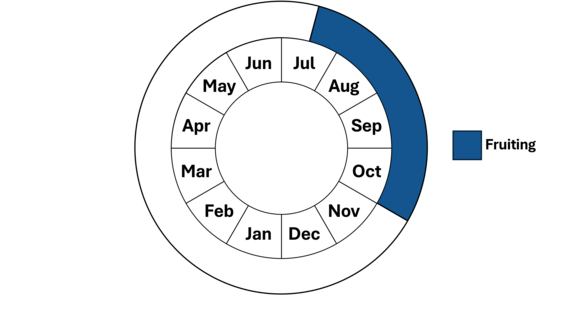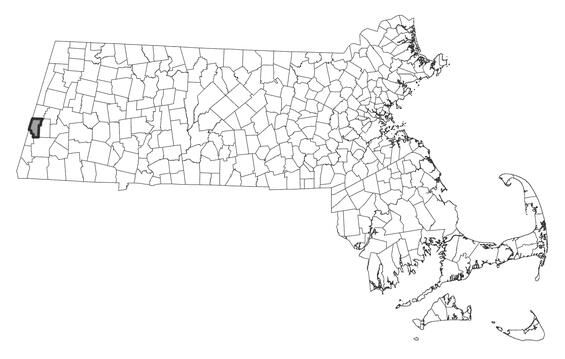- Scientific name: Potamogeton friesii
- Species of Greatest Conservation Need (MA State Wildlife Action Plan)
- Endangered (MA Endangered Species Act)
Description
Fries’ pondweed (Potamogeton friesii) is a delicate, submersed aquatic herb rooted to the substrate from erect, slightly compressed, stems 10-135 mm (up to 5 in) long. Leaf blades are alternately arranged, linear, sessile, and with acute to apiculate (abruptly pointed) tips. Fries’ pondweed has no floating leaves; all leaves are submersed. At the base of each leaf is a sheath-like stipule, completely free from the blade, and a pair of small (0.7 mm; 0.03 in), raised, green to goldish “nodal” glands. Flowers are inconspicuous and arranged in short cylindrical spikes held just above the water surface. Fruits are small (1.8-2.5 mm; 0.7-0.1 in) and seed-like, olive-green to brown, with short (≤ 0.7 mm; 0.03 in) erect beaks. The formation of soft, leafy winter buds, or turions, is common in leaf axils.
The identification of linear-leaved Pondweeds (Potamogeton spp.), in general, is difficult and requires careful microscopic (or hand lens) examination of leaves, stipules, nodes, winter buds, and fruit. Fries’ pondweed is identified by its slender (1.2-3.2 mm [0.05-.0.13 in] wide), submersed, five (to seven) veined blades, 2.3-6.5 cm (~1-2.6 in) in length; paired nodal glands; and unfused, whitish, coarsely fibrous stipules (0.5-2.0 cm; <1 in) shredded at the tips. Individuals can be easily recognized by their distinctive turions. The turions are 1.5-5 cm (0.6-2 in) long and 1.5-4 mm wide, with two to three reduced inner leaves positioned at right angles (90°) to the two to three outer leaves. The base of the outer leaves is corrugated, a feature also unique to the species.
Individuals of Fries’ pondweed closely resemble other, more common, narrow-leaved pondweeds that also lack floating blades. In the absence of turions for observation, Fries’ pondweed can be separated from leafy pondweed (P. foliosus) by the latter species’ fewer- veined (three to five) leaves, lack of nodal glands, and wavy-keeled fruits; and from slender pondweed (P.pusillus) by its fewer-veined (one to three) leaves and delicate, usually greenish, stipules.
Life cycle and behavior

Population status
Fries’ pondweed is listed under the Massachusetts Endangered Species Act as endangered. All listed species are protected from killing, collecting, possessing, or sale and from activities that would destroy habitat and thus directly or indirectly cause mortality or disrupt critical behaviors. The Massachusetts Natural Heritage & Endangered Species Program has 5 records from 2 counties: Berkshire and Middlesex. One of these records has been observed within the last 25 years.
Distribution and abundance
Fries’ pondweed occurs from Newfoundland west to Alaska, and south to Utah, Indiana, and Pennsylvania.

Distribution in Massachusetts. 1999-2024. Based on records in the Natural Heritage Database.
Habitat
Fries’ pondweed inhabits calcareous waters of lakes, ponds, and slow streams to 3 m (~10 ft) deep. Plants found in association with Fries’ pondweed include slender pondweed (Potamogeton pusillus), Illinois pondweed (P. illinoensis), curly pondweed (P. crispus), flatstem pondweed (P. zosteriformis), big-leaved pondweed (P. amplifolius), sago pondweed (Stuckenia pectinata), water crowfoot (Ranunculus aquatilis), common bladderwort (Utricularia macrorhiza), water stargrass (Heteranthera dubia), northern waterweed (Elodea canadensis), and muskgrass (stonewort) (Chara sp.).
Healthy habitats are vital for supporting native wildlife and plants. Explore habitats and learn about conservation and restoration in Massachusetts.
Threats
As Fries’ pondweed occurs in open waters, alteration in the hydrologic regime, water quality, or erosion and sedimentation rates could have an impact on a population. Competition from invasive aquatic species could also reduce the available habitat of Fries’ pondweed. Mechanical or non-specific chemical control of invasive species is a threat as well.
Conservation
All active management of state-listed plant populations (including invasive species removal) is subject to review under the Massachusetts Endangered Species Act and should be planned in close consultation with the MassWildlife’s Natural Heritage & Endangered Species Program.
References
Crow, G.E., and C. B. Hellquist. 2000. Aquatic and Wetland Plants of North America. Vol. 2. University of Wisconsin Press, Madison.
Contact
| Date published: | May 5, 2025 |
|---|